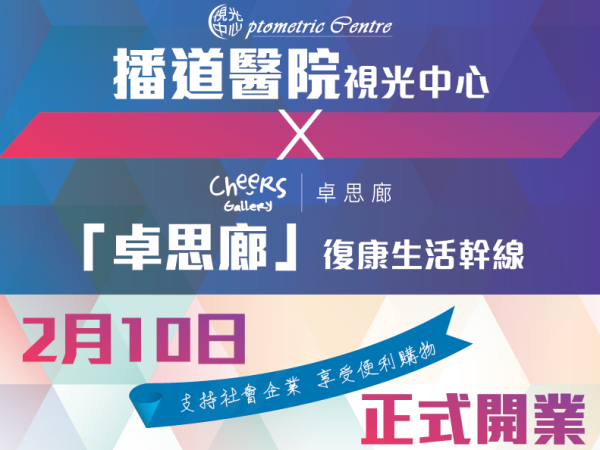Allied Health Service
Optometric Centre

From Now on, the Evangel Hospital Optometric Centre collaborates with "Cheers Gallery" Rehab Links to provide more selected products to the public in a one-stop service, bringing more comprehensive services to the community. In addition to continuing to provide eyewear fitting services, the store will also sell a variety of health products, medical and rehabilitation supplies. This not only offers convenient shopping for everyone but also provides employment opportunities for people with disabilities. We appreciate your support!
Selected products include: nutritional supplements, health supplements, diabetes supplies, and care products.
Opening Hours:
Monday to Saturday: 10am-6pm (Lunch Break: 2pm-3pm, closed on Sundays and public holidays)
Address:
Ground Floor, 15 Fu Ning Street, Chi Chun Lau, Chun Seen Mei Chuen, Kowloon City
Enquiry:
- The Evangel Hospital Optometric Centre (Appointments via WhatsApp: 5741 4930)
- "Cheers Gallery" Rehab Links (Phone: 2788 3113, Orders or Inquiries: 67364941)

The brand new Optometric Centre of the Evangel Hospital located at Chun Seen Mei Chuen (opposite of Evangel Hospital) is newly opened in Dec 2017. It provides comprehensive eye care assessments, refraction and optical dispensing services to the neighborhood. The new Centre adopts simple and modern design, providing you a comfortable environment while enjoying our professional services.

Our Services
- Visual Acuity Measurement
- Refraction
- Intra-ocular Pressure Measurement
- Cataract Examination
- Binocular Vision Assessment
- External Ocular Health Assessment
- Color Vision
- Stereopsis Test
- Cycloplegic Refraction
- Fundus Photography

Common Visual Problems
Myopia (short-sightedness) is most frequently caused by the pro-longed length of the eyeball. The visual image is formed in front of the retina and blurry distant vision is resuled. Myopia can be corrected by using concave lenses with correct power to help bring back the image focus onto the retina.
Hyperopia (long-sightedness) occurs when the length of the eyeball being too short than normal, the visual image would therefore be formed behind the retina. Infants usually come with certain degree of hyperopia, such hyperopia would be decreased upon growth of the children. If the hyperopic prescription is mild, our eyes can accommodate and focus the image on the retina without causing any blur. For patients with over +3.00D of hyperopia who need to perform near tasks like reading and using computer frequently, convex lenses are often prescribed to relieve their stress.
Astigmatism is a condition caused by the non-spherical curvature of the cornea. The image formed on the retina would become blurry and elongated as a result. Astigmatism can occur in combination with hyperopia or myopia, and it can be treated with cylindrical lenses.
Presbyopia is caused by the decrease of elasticity of the crystalline lens and the decrease of accommodative power of the ciliary muscles which apply forces on the lens. The condition generally occurs after the age of 40. Presbyopia can be corrected with single vision lenses (reading glasses), bifocal lenses or progressive addition lenses.
Amblyopia (lazy eye) is characterized by poor vision even with the aid of glasses. During visual development, if either eye cannot receive a clear retinal image, the neural connection between that particular eye with the brain would be severely hindered. Amblyopia would be resulted if such condition does not change. It normally affects one eye only and children with anisometropia (difference of power between 2 eyes ≥ 3.00D) or strabismus are more likely to suffer from amblyopia. If detected early, amblyopia can be treated with appropriate prescription, eye patching and vision training.
Strabismus is caused by the misalignment of two eyes. When one eye fixates on a target and the other eye turns inward, it is called internal squint. On the other hand, when the eye turns outward, it is called external squint. The condition is often caused by imbalance of the extra-ocular muscles of the eyes or anisometropia. Strabismus can be treated with spectacles, vision therapy or surgery.
Color Vision Deficiencies &
Color Blindness are usually congenital disorders. Color vision deficiency is characterized by the inability to differentiate certain colors, most commonly, red and green confusion, with yellow and blue confusion sometimes. This hereditary condition mainly affects male. Certain eye diseases like macula degeneration would also result in different levels of color deficiency. The condition would be more obvious in dim light environment. Color blindness, on the other hand, patients would just perceive colorless vision despite of black, white and different levels of grey.
Congenital color vision could not be cured. When children are diagnosed with color vision defects, their teachers should be informed so that their educational instruction would not be color-coded. In addition, they should be aware that certain occupations are not suitable for them (e.g. pilot).
Glaucoma is a disease caused by the damage of retinal ganglion cells and the optic nerve, results in vision loss and constriction of visual field. The incidence of getting glaucoma is higher for people having myopia. Symptoms are not noticeable to patients in the early stage. Glaucoma leads to the constriction of visual field from peripheral towards the central field, while an entire loss of visual field and blindness would be resulted eventually if untreated.
Cataract is a condition which the crystalline lens in eye turns hazy and reduced in transparency. The most common cause of cataract is ageing, leading the lens to become cloudy and hardened. Other causes including congenital causes, trauma, excessive exposure to ultra violet or other general health problems. Blurry vision is the most common symptom of cataract, sometimes associated with experience of glare when viewing light sources. Cataract could be treated by surgery with intra-ocular lens implemented to improve the vision of the patient.
Macula is the central part of the retina with high density of photoreceptors. It is responsible for central and high acuity vision. Age related macular degeneration begins with pigment changes around the macular region. Abnormal growth of blood vessels, leakage of blood, scarring and edema may be resulted in severe cases. Early changes could have no obvious symptoms but as the condition progresses, it will cause blurry and distorted central vision and complete loss of central vision eventually if left untreated.
Retinal Detachment is a disorder caused by the thinning and degeneration of peripheral retina which results in breaks, tears or holes on the retina, followed by tearing off of the retina from its normal position. This leads to loss of functions of the photoreceptor cells. Elongated eyeball (frequently associated with high myopic people), eye trauma, diabetes, tumor or inflammation are more prone to have retinal detachment. Common symptoms include increased number of floaters, light flashes and the loss of visual field. If there is a sudden dramatic increase of floaters, flashes of light, shimmering, or if the visual field appeared slanted/ distorted, patients should consult a specialist immediately. Retinal detachment can permanently damage patients’ visual functions.

Tips to PROTECT your eyes
- Keep the prints at a minimum distance of 30 cm from the eyes.
- Let the eyes relax and see distant things (about 6m) 3-5 minutes after every 20 minutes near task like reading, using computer or doing homework.
- Adequate sleep so that the eyes could have entire rest.
- Outdoor activities like hiking help relax of the eyes.
- Adequate but not stinging room lighting at the working environment.
- Avoid starring at a flashing target, to reduce the chance of getting headache and eye fatique.
- Keep a balanced diet. Have more intake of food rich in vitamins and anti-oxidants like broccoli and corns.



